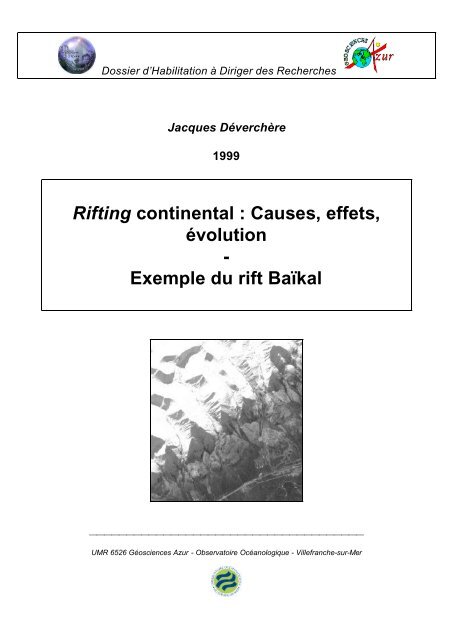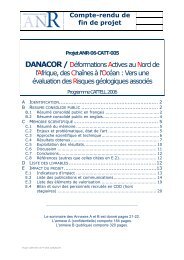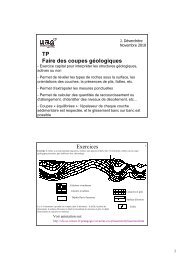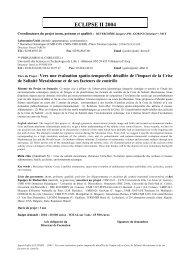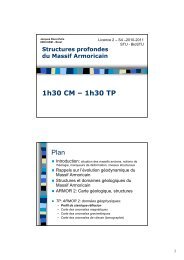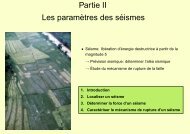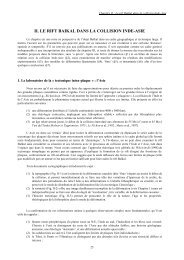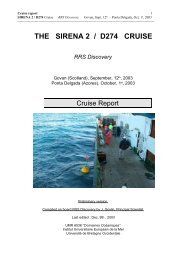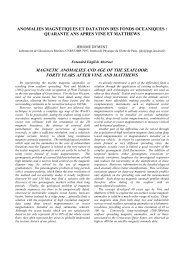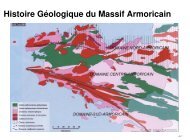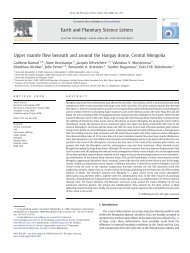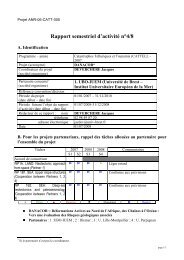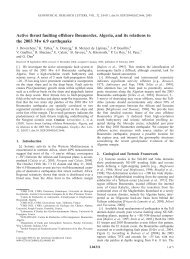Introduction - Remerciements - Plan - liste des personnes ayant une ...
Introduction - Remerciements - Plan - liste des personnes ayant une ...
Introduction - Remerciements - Plan - liste des personnes ayant une ...
Create successful ePaper yourself
Turn your PDF publications into a flip-book with our unique Google optimized e-Paper software.
Dossier d’Habilitation à Diriger <strong>des</strong> Recherches<br />
Jacques Déverchère<br />
1999<br />
Rifting continental : Causes, effets,<br />
évolution<br />
-<br />
Exemple du rift Baïkal<br />
⎯⎯⎯⎯⎯⎯⎯⎯⎯⎯⎯⎯⎯⎯⎯⎯⎯⎯⎯⎯⎯⎯⎯⎯⎯⎯⎯⎯⎯⎯⎯⎯⎯⎯⎯⎯⎯<br />
UMR 6526 Géosciences Azur - Observatoire Océanologique - Villefranche-sur-Mer
Dossier d’Habilitation à Diriger <strong>des</strong> Recherches<br />
Jacques Déverchère<br />
1999<br />
Une synthèse de l'activité scientifique sur:<br />
Rifting continental: Causes,<br />
effets, évolution<br />
-<br />
Exemple du rift Baïkal<br />
Présentée le 20 octobre 1999 devant le Jury composé de:<br />
Jean-Philippe AVOUAC CEA/LdG, Bruyères-le-Châtel,<br />
rapporteur<br />
Gilbert BOILLOT Université Pierre et Marie Curie,<br />
Villefranche/Mer<br />
Jean-Pierre BRUN Université de Rennes 1, rapporteur<br />
Michel DIAMENT Institut de Physique de Globe,<br />
Paris<br />
Cynthia EBINGER Université Royal Holloway de<br />
Londres, rapporteur<br />
Laurent JOLIVET Université Pierre et Marie Curie,<br />
Paris, rapporteur<br />
⎯⎯⎯⎯⎯⎯⎯⎯⎯⎯⎯⎯⎯⎯⎯⎯⎯⎯⎯⎯⎯⎯⎯⎯⎯⎯⎯⎯⎯⎯⎯⎯⎯⎯⎯⎯⎯<br />
UMR 6526 Géosciences Azur - Observatoire Océanologique - Villefranche-sur-Mer
<strong>Plan</strong>, Résumé, <strong>Introduction</strong><br />
Dossier HDR Jacques Deverchère<br />
Rifting continental: causes, effets, évolution<br />
-<br />
Exemple du rift Baïkal<br />
PLAN<br />
Préambule<br />
Résumé étendu en anglais<br />
<strong>Introduction</strong><br />
I. PROBLEMATIQUE ET DEMARCHE SCIENTIFIQUE<br />
A. PROBLEMATIQUE : Signification et importance <strong>des</strong> rifts continentaux<br />
1. Place <strong>des</strong> rifts dans la tectonique « interplaque » et « intraplaque »<br />
1-A. Qu’attendre de la <strong>des</strong>cription <strong>des</strong> mouvements relatifs <strong>des</strong> gran<strong>des</strong> plaques <br />
1-B. Sur l’importance <strong>des</strong> forces responsables de la déformation intraplaque et leur modélisation<br />
2. Manifestations majeures associées aux rifts : quelle logique <br />
3. Echelle globale : Convection du manteau, héritage continental et rupture lithosphérique<br />
4. Echelle régionale : Géométrie et mo<strong>des</strong> d’évolution <strong>des</strong> rifts dans le temps et l’espace<br />
B. DEMARCHE: de la "sismo-géologie" à l'analyse <strong>des</strong> causes et effets de la déformation<br />
lithosphérique en extension<br />
1. Les séismes comme marqueurs de la déformation active<br />
1-A. Qu’attendre de la microsismicité <br />
1-B. Stratégies d’analyse <strong>des</strong> mécanismes aux foyer<br />
1-C. Principales limites dans l’interprétation de la microsismicité<br />
2. L’intégration de la « sismo -géologie » dans un ensemble d’observations géophysiques et géologiques<br />
3. Les propriétés intrinsèques de la lithosphère continentale à considérer<br />
3-A. Importance <strong>des</strong> hétérogénéités et de la stratification rhéologique<br />
• Hétérogénéités rhéologiques et anisotropie mécanique<br />
• Fluage de la lithosphère inférieure<br />
• Degré de couplage croûte supérieure-inférieure-manteau<br />
3-B. Effets de la rigidité lithosphérique et comportement thermo-mécanique de la lithosphère<br />
• L’épaisseur élastique équivalente (EEE) : quel apport <br />
• Les épaulements de rift et les modèles thermo -mécaniques en extension<br />
• Les instabilités périodiques (flambage et boudinage)<br />
1
II. LE RIFT BAIKAL DANS LA COLLISION INDE-ASIE<br />
<strong>Plan</strong>, Résumé, <strong>Introduction</strong><br />
• 1. Le laboratoire de la « tectonique intra-plaque » : l’Asie<br />
• 2. Bilans cinématiques et de masse<br />
• 3. Les modèles de déformation basés sur les expériences analogiques<br />
• Le modèle initial : le poinçon rigide<br />
• Les modèles dimensionnés intégrant les forces de volume<br />
• 4. Les modèles utilisant <strong>des</strong> mesures de déformation quaternaires sur failles<br />
• Les modèles en blocs quasi-rigi<strong>des</strong><br />
• Les modèles en blocs peu ou non rigi<strong>des</strong><br />
• 5. Les modèles simulant un champ de déplacement fini depuis 50 Ma<br />
• Les modèles numériques de déformation continue<br />
• Modèle cinématique par reconstruction<br />
• 6. Les modèles utilisant <strong>des</strong> mesures de déformation instantanée<br />
• Les modèles basés sur la sismicité du siècle<br />
• Les modèles basés sur les mesures VLBI et GPS<br />
• 7. Conclusions : distribution et évolution de la déformation en Asie<br />
III. LE RIFT BAIKAL ET LA DEFORMATION LITHOSPHERIQUE<br />
A. Disposition géométrique et évolution tectonique du rift Baïkal<br />
• 1. Morphologie régionale<br />
• 2. Histoire géologique<br />
• Accrétion de blocs au craton archéen et collisions<br />
• Naissance et évolution <strong>des</strong> bassins du rift<br />
• Volcanisme Cénozoïque et flux de chaleur<br />
• 3. Sismicité et failles actives<br />
• 4. Champ de contraintes actuels et déplacements récents<br />
• 5. Modèles cinématiques à l’échelles régionale<br />
• modèle régional de rotations de blocs rigi<strong>des</strong><br />
• modèles en pull-apart<br />
• modèles en rifting oblique<br />
• modèle plan en éléments finis<br />
B. Mécanismes de l’ouverture et structures profon<strong>des</strong> du rift Baïkal<br />
• 1. Segmentation <strong>des</strong> failles et épaisseur sismogène<br />
• 2. Tomographie sismologique, vitesses de phase et dispersion <strong>des</strong> on<strong>des</strong> sous la zone de rift<br />
• 3. Gravimétrie et modélisations thermo -mécaniques<br />
• 4. Modélisations expérimentales et numériques en coupe<br />
2
<strong>Plan</strong>, Résumé, <strong>Introduction</strong><br />
IV. PERSPECTIVES DE RECHERCHE<br />
• 1. Evolution biphasée et modèle de rifting passif dominant<br />
• Le problème <strong>des</strong> causes du biphasage<br />
• Le problème de la direction d’extension récente<br />
• Le problème du dispositif géométrique plan<br />
• 2. Rhéologie, panaches, et convection<br />
• Le problème du rôle de la rhéologie et <strong>des</strong> instabilités<br />
• Le problème de la dimension et de l’importance de la remontée asthénosphérique sous le rift<br />
• Le problème de « Raft tectonics » et de convection : le rôle de la subduction lointaine<br />
• 3. Projets à court et moyen termes<br />
• En Asie<br />
• En domaine Ligure<br />
ANNEXE 1<br />
Activités de formation, recherche et enseignement<br />
1. Activités de Formation à la Recherche<br />
2. Responsabilités administratives d’animation de la Recherche<br />
3. Curriculum Vitae<br />
4. Liste <strong>des</strong> publications et communications<br />
ANNEXE 2<br />
(dossier séparé)<br />
Publications sélectionnées<br />
(concernant uniquement le dossier d’habilitation)<br />
Les travaux sont numérotés dans l’ordre chronologique de parution ou de préparation. Les publications 2, 5, 7,<br />
8, 10, servent de support au texte de synthèse essentiellement dans le Chapitre III-A (Disposition géométrique et<br />
évolution tectonique du rift Baïkal), et les publications 1, 3, 4, 6, 9, 11, dans le Chapitre III-B (Mécanismes de<br />
l’ouverture et structures profon<strong>des</strong> du rift Baïkal).Les autres publications concernant les recherches dans les An<strong>des</strong>, le<br />
domaine Ligure et l’Indonésie, ne sont pas reproduites ici. Elles sont mentionnées en Annexe 1.<br />
3
<strong>Plan</strong>, Résumé, <strong>Introduction</strong><br />
Rifting continental: Causes, effets, évolution -<br />
Exemple du rift Baïkal<br />
Préambule<br />
L’activité présentée ici n’a un sens que par le travail collectif au quotidien qu’elle a permis. En tout premier lieu,<br />
je pense aux étudiants en thèse, et particulièrement Frédérique Houdry et Carole Petit, mes deux plus proches<br />
collaboratrices, qui, par leurs talents multiples et leurs qualités scientifiques et humaines, ont rendu les missions<br />
sibériennes passionnantes et ont enrichi considérablement ce travail. Que Carole puisse trouver rapidement un poste à la<br />
mesure de ses gran<strong>des</strong> possibilités. Je n’oublie pas Christine Fontaine, Nadège Rollet et Olivia Lesne, qui ont su relever<br />
le défi d’un travail parfois fastidieux, chac<strong>une</strong> dans leur domaine. Merci encore aux étudiants de D.E.A. (Eric Chaumillon,<br />
Florence Dambricourt, Frédéric Bartoli, Hélène Le Fur, Lies Loncke) et de maîtrise dont l’apport et l’implication ont<br />
également été très importants.<br />
Etre enseignant-chercheur c’est aussi un équilibre parfois difficile à trouver dans sa double fonction. J’ai connu<br />
à Villefranche-sur-Mer <strong>des</strong> conditions d’enseignement en Géophysique marine, certes perfectibles, mais surtout très<br />
stimulantes, et qui ont apporté de gran<strong>des</strong> satisfactions mutuelles, tant les étudiants ont besoin d’un enseignement basé<br />
sur l’expérimentation directe, la mise en application de connaissances théoriques, et finalement <strong>une</strong> géophysique<br />
concrète : je veux simplement témoigner ici de l’intérêt évident qu’ont manifesté l’immense majorité <strong>des</strong> étudiants en<br />
visite à l’Observatoire pour cette forme d’enseignement, et redire comme au moment de mon recrutement la grande<br />
chance que ce métier représente.<br />
Parmi les chercheurs qui ont compté dans ces années entre la région Ligure, la Russie sibérienne et l’Indonésie,<br />
je tiens à remercier particulièrement quatre <strong>personnes</strong> : Eric Calais, dont la passion pour la science est communicative, et<br />
qui a rendu possible un ‘changement de vitesse’ essentiel dans le chantier d’Asie, par son talent, sa disponibilité, son<br />
efficacité ; Michel Diament, qui m’a donné l’impulsion initiale vers la Russie, et a su procurer à nombre de ses ‘anciens’<br />
étudiants dont moi-même la confiance nécessaire pour continuer leur chemin ; Vladimir San’kov, avec qui nous avons<br />
appris peu à peu à faire tomber les barrières culturelles entre nos deux communautés, et qui a assuré la continuité de cette<br />
coopération après la tragique disparition d’Alexandre Solonenko, le premier et inoubliable compagnon de route ; et<br />
Marie-Odile Beslier, avec qui nous avons partagé les angoisses de la campagne MALIS, et qui a l’exigence et la patience<br />
qui me font si souvent défaut.<br />
Je remercie également les <strong>personnes</strong> qui m’ont manifesté leur confiance dans <strong>des</strong> moments importants,<br />
particulièrement Gilbert Boillot, Georges Mascle, Jean Mascle, Marc Tardy, Jean Virieux, et Hervé Chamley, que ce soit au<br />
moment de mon recrutement, au sein du laboratoire devenu Géosciences Azur en 1996, et lors de mes participations dans<br />
<strong>des</strong> commissions, conseils, groupes ou comités. Je veux aussi mentionner ici la présence ‘collective’ d’autres <strong>personnes</strong>,<br />
sans qui la vie d’enseignant-chercheur perd beaucoup d’intérêt, et à qui je dois de sincères remerciements : Françoise<br />
Sage (avec mention spéciale pour le ‘supplément’ enseignement, si souvent oublié), Guy Ouillon, Françoise Courboulex,<br />
Jocelyne Gosselin, Francine Calcagno, David Graindorge, Philippe Charvis. Je veux encore remercier quelques<br />
compagnons (parfois d’infort<strong>une</strong> !) lors de campagnes en mer (Laurent Royer, Nicole Béthoux, Stéphane Gaffet, Alain<br />
Moreau, Jean-Pierre Réhault, Marc Sosson, Pol Guennoc, Jean-François Stéphan, Yann Hello, Bruno Savoye, et tout<br />
récemment Alain Anglade) et sur le ‘terrain’ parfois ingrat <strong>des</strong> sites du Laboratoire (Yves Descatoire, Jean-Jacques<br />
Pangrazi, Reine Saighi, Caroline Ramel, Véronique Gourbaud, Suzanne Vella, Véronique Pisot). Enfin je tiens à rendre<br />
hommage à l'action de MM. Va ssiliev et Baskévitch à l'Ambassade de France à Moscou, qui a rendu possible les<br />
nécessaires échanges entre nos deux pays.<br />
J’ai finalement le plaisir de dire mes remerciements aux membres du jury qui ont accepté d’examiner mon activité<br />
sans réticence : d’abord aux quatre rapporteurs, Cindy Ebinger, Jean-Philippe Avouac, Jean-Pierre Brun, Laurent Jolivet,<br />
et à Gilbert Boillot et Michel Diament. Deux derniers messages : que les ‘Liguriens’, et notamment Nicole Béthoux, la<br />
‘première’ sismologue de la région, et Marie-Odile Beslier, me pardonnent de laisser ici de côté la Méditerranée : elle reste<br />
cependant présente en filigrane à travers cet examen de l’extension continentale, et ce n’est que partie remise ; et que<br />
Cindy me pardonne d’avoir quelque peu sacrifié la comparaison avec ‘son’ rift ! Mais je sais que le travail commun avec<br />
Carole comble déjà cette lac<strong>une</strong>.<br />
4
<strong>Plan</strong>, Résumé, <strong>Introduction</strong><br />
Résumé étendu en anglais<br />
Continental Rifting: causes, effects, evolution -<br />
Example of the Baikal rift<br />
This report for ‘Habilitation à Diriger <strong>des</strong> Recherches’ presents a summary of my research activity about the<br />
Baikal rift which has began ten years ago, when I obtained my present position as Assistant Professor at Villefranchesur-Mer<br />
Observatory (UPMC). Activities concerning the geodynamics of the Ligurian Sea and previous studies in the<br />
An<strong>des</strong> (Ph. Thesis) are not developped in this report. During the last 10 years I have trained 4 Ph.D. students (2 in full<br />
responsability), 6 ‘DEA’ students, and 8 students in ‘Maîtrise’. I was also involved in regular teaching tasks in the<br />
Observatory, organization of a European Summer School, national evaluations of grants and Universitary activities,<br />
CNRS Committees, and in several proposals for scientific fundings (see Annex 1 for details). This activity has also<br />
implied several field trips and sea cruises. I have participated to 15 publications in International Journals (level ‘A’), plus<br />
3 recently submitted, and to 63 scientific meetings. I was the first author in 4 ‘A’ publications, and second author in 4<br />
others after one of my students (see Annex 1 for a full list and Annex 2 where 11 publications concerning the Baikal rift<br />
are reproduced).<br />
Chapter I gives a brief review of the problems that are currently debated about continental rifts and the way I<br />
have used and complemented ‘seismo -geology’ for the analysis of causes and effects of continental deformation under<br />
extension. Chapter II is a critical review of the deformation pattern in Asia during Tertiary, which aims at situating the<br />
Baikal rift in this important tectonic context. Chapter III is an overview of the main results obtained concerning the<br />
structure, evolution and dynamics of the Baikal rift, and puts in perspective the 11 publications reproduced in Annex 2.<br />
Finally, Chapter IV briefly opens some perspectives of work.<br />
What I have tried to perform, together with several colleagues, is a multidisciplinary study of the Baikal rift<br />
system. This was done in the framework of a collaboration between the Institute of the Earth’s Crust (Irkutsk) and<br />
Géosciences Azur (CNRS-UPMC, Nice, France). We attempt to gather several geophysical and geological data (either<br />
revised or new) and to interpret them with some caution, in order to determine a realistic picture of the on-going<br />
deformation pattern in the Baikal area, and more widely, to better understand the dynamics of the lithospheric<br />
deformation in an intracontinental setting. Our main objectives were the following : (1) <strong>des</strong>cribe the geometry and rate of<br />
active faulting using satellite imagery, field investigations, and seismicity, (2) directly measure crustal deformation and<br />
fault motion using GPS geo<strong>des</strong>y, (3) determine the stress field using earthquake source data, and (4) understand the<br />
physical mechanisms at work through numerical modeling. A number of funding agencies made this project possible :<br />
INTAS, NATO, the Siberian Branch of the Russian Academy of Science, the Mongolian Academy of Science, the French<br />
Ministry for Foreign Affairs, the French National Center for Scientific Research (CNRS), and University Pierre and Marie<br />
Curie.<br />
1. Geometry, style and rate of faulting<br />
We have first focused our efforts on the northern Baikal rift because active faults are easier to <strong>des</strong>cribe there<br />
than below Lake Baikal. We have performed a detailed morphotectonic analysis of late Quaternary faulting in this region<br />
characterized by ranges and basins distributed over more than 800 km along strike. Remote sensing techniques (SPOT,<br />
METEOR scenes, aerial photographs) were used to map the active fault network which displays a general en échelon<br />
distribution from the northern Lake Baikal to the easternmost basin, with ~30 km-spaced overstepping segments of 10-80<br />
km in length [1, 2]. Most faults have a dominant dip-slip component over their Cenozoic history. The inherited crustal<br />
fabric strongly influences the overall geometry of the rifted basins. We use 54 14 C ages of post-glacial terraces near the<br />
footscarps of the Muya basin to date offsets measured inside alluvial fans [3]. The last main post-glacial event in this<br />
area appears to be the early Holocene optimum dated at ~10 ± 2 ka, following the onset of deglaciation at ~13 ka.<br />
Therefore, a detailed levelling across two terraces offset by the Taksimo fault (West Muya basin) shows consistent<br />
minimum vertical slip rates of 1.6±0.6 mm yr -1 . Using 30 other active scarps analyzed in the field, we found a lower bound<br />
for horizontal velocity of 3.2±0.5 mm yr -1 across the Northern rift. We then compared directions of slip vectors from<br />
Holocene field data and slip directions from earthquake fault plane solutions : although local discrepancies appear, the<br />
mean directions of stress inverted (~N130E and ~N155E, respectively) are comparable within uncertainties and favor a<br />
rifting obliquity of about 30-40°. Extrapolating our Holocene rates, we estimate basin ages younger than generally<br />
believed (less than 7 Ma) and propose a spatial and temporal evolution of rifted basins consistent with experimental<br />
models of oblique rifting. Total amounts of extension and vertical throw (~7 km and ~12 km, respectively) across major<br />
faults appear rather constant from the central to the northern rift. These results favor a progressive development of<br />
asymmetric grabens in this part of the rift zone through time and indicate a strong rheological control on deformation<br />
which seems enhanced by other contributions than the far-field effect of the India-Eurasia collision.<br />
A preliminary analysis of a new set of satellite images (SPOT, Landsat Thematic mapper and ERS radar image)<br />
5
<strong>Plan</strong>, Résumé, <strong>Introduction</strong><br />
covering the Tunka-Baikal area provi<strong>des</strong> insights on some active faults : (1) the Sayan fault, a continous system along<br />
130 km, depicts at 3 points river offsets which attest for a recent sinistral strike-slip movement, which magnitude is still<br />
undetermined ; (2) the north-Tunka (West) presents discontinous, en-échelon segments with a variable size from 3 km to<br />
10 km and a probable compressional component; (3) the south-Tunka fault vanishes inside the basin from west to east :<br />
although different small segments are obvious, no clear, recent offsets are detected along them, suggesting a transfer of<br />
motion to the north on the Sayan and north-Tunka faults.<br />
2. GPS measurements and long term prediction of earthquakes<br />
Four campaigns of Global Positioning System measurements were performed between 1994 and 1998 in the<br />
southern and western Baikal region. Our results [4] show a total extension of 4.5+/-1.2mm/yr in a NW-SE direction in the<br />
southern part of the Baikal rift zone and a velocity gradient perpendicular to the major active faults, indicating elastic<br />
strain accumulation. This velocity rate is in good agreement with results of Holocene horizontal displacements on faults<br />
of the SBR [2, 3] but is at least two times greater than the prediction of most deformation models of Asia [5,6]. The strain<br />
is localized on a narrow (50 to 100 km wide) rift structure which appears to be concentrating the present-day deformation<br />
between Eurasia and East China. A comparison between the GPS results and the seismic moment released by historical<br />
earthquakes suggests that elastic strain is currently accumulating in the Baikal rift zone along active faults that have the<br />
potential for a M = 7.5 earthquake if that elastic strain were to be released in a single event today. If aseismic slip is<br />
neglected, we hypothesize recurrence intervals of 150-350 years for large (M~7.5-7.7) events along the lake shoreline,<br />
which could imply the occurrence of a strong shock in the near future. In the South and Central Baikal region, field<br />
<strong>des</strong>cription of more than 40 paleoscarps, and radiocarbon datings of seismogenic deformations have provided<br />
recurrences of less than 2000 years [7], a value similar to the one found in the North [3]. We are currently extending our<br />
GPS network to Mongolia, where 20 sites covering the western half of the country have been measured for in 1997 and<br />
1998. First results favor an eastward movement of the Mongolian block. These results could reflect the dynamic effect of<br />
the Pacific-Eurasia subduction in addition to the well-kown effect of the the India-Eurasia collision. Other causes could<br />
be a "ridge push" effect below the rift, or a buckling of the lithosphere in response to collisional tectonics along the<br />
Siberian Craton. We need additional GPS measurements and tests of dynamic deformation models to discriminate<br />
between these possible effects.<br />
3. Deviatoric stress changes<br />
The problem of the forces responsible for the opening of the Baikal rift is still enigmatic. Analyses of individual<br />
strain directions provided by focal mechanisms of earthquakes is a classical way to determine the consistency of fault<br />
kinematics. We have considered useful to proceed to local deviatoric stress inversions as often as possible, and then to<br />
use these tensors to predict slip directions along main faults. More than 300 focal mechanisms located along the whole<br />
Baikal rift were first used [8]. The stress field is varying at different scales of observation: when looking at central Asia,<br />
the maximum horizontal stress Shmax directions remain rather constant (with a fan-shape geometry) when the tectonic<br />
regime goes from transpressional (Mongolian Altai) to extensional (Baikal). At the scale of the Baikal rift, clear variations<br />
of the stress regime are observed, from an extensional regime in the central part of the rift to wrench ones in its northern<br />
and southern ends. Finally, at the scale of 100 km, systematic Shmax reorientations occur close to major rift faults. We<br />
thus infer that the interaction between collisional processes and inherited structures may have a strong influence on rift<br />
dynamics. Predicted slips show two distinct parts of the rift: the South Baikal Rift is characterized by a constant trend<br />
(around N100°E), meanwhile the North Baikal Rift exhibits rotations involving at least three crustal blocks. These surficial<br />
structures and motions can be easily explained by an interaction between the regional compression linked to the India-<br />
Asia collision and the geometry of the hardly deformable Siberian platform. This suggests a large-scale cracking<br />
(releasing bend) of the lithosphere in the Baikal region. A plane, simple finite element model of deformation confirms this<br />
pattern at broader scale [9].<br />
Recently, we have analyzed stress changes from Lake Baikal up to the Bolnai fault in Mongolia thanks to a new<br />
database of reliable focal solutions of earthquakes (110 all-size mechanisms). There is a smooth, progressive change of<br />
Shmax from South to North, with a trend parallel to the N-S faults of the grabens of Busingol and Khubsugul. Only the<br />
Tunka basin region shows a quick change to a E-W strike. Elsewhere, the general strike is in agreement with a fanshaped,<br />
large-scale distribution of Shmax, consistent with the compressive stress field imposed by the India-Eurasia<br />
collision. Extensional regimes observed are explained by: (i) the position of Busingol, Darkhat and Khubsugul basins<br />
inside a block between two large strike-slip faults, suggesting a pull-apart or a tension gash mechanism within a<br />
transpressional regime ; (ii) the position of Lake Baikal against a major suture zone, which strike favors an opening<br />
controlled by the main Sayan fault linked to the eastward escape of the Mongolian block.<br />
6
4. Mechanical behaviour of the lithosphere and deep structures of the rift<br />
7<br />
<strong>Plan</strong>, Résumé, <strong>Introduction</strong><br />
We have examined the crustal structure and lithospheric flexure of the BRZ by means of gravity modeling. We<br />
modelled the Bouguer Anomaly (BA) along six 1200-km-long gravity profiles [10, 11]. We first evidenced that continuous<br />
elastic plate flexure due to surface loading cannot explain the observed BA. Then we introduced plate discontinuities<br />
coupled with a realistic brittle-elasto-ductile plate rheology to model external tectonic forces acting on the plates and to<br />
determine the Moho geometry. The clearest expression of extensional processes occurs in the central part of the rift,<br />
which exhibits the highest crustal thinning and depicts rift shoulders that have been explained in the southern-central<br />
Lake by mechanical (flexural) unloading [12]. It evolves southwards to a rapidly increasing compression, resulting in an<br />
overthickening of the southern plate's crust and in the long-wavelength flexure of the Siberian plate. North of the central<br />
rift, crustal thinning (which is always less than 7 km) gives way to a more diffuse zone of deformation inside the Sayan-<br />
Baikal folded belt. Based on plate flexure modellings, we find that the rift shoulders surrounding the Central and North<br />
Baikal basins are not supported by upward bending plate, but have a deep crustal root caused by a downward flexure.<br />
The other parts of the rift depict two adjacent plates with antithetic flexures. We also observe that the axial mantle<br />
material, although affected by velocity reductions from place to place, is not related to a large-scale asthenospheric<br />
upwelling, since the lithosphere rheological interfaces are not significantly disturbed. It seems to us that a major<br />
asthenospheric upwelling reaching the Moho (suggested by [13, 14, 15]) would produce much stronger thermal effects<br />
and mechanical weakening. Instead, we favor the role of horizontal forces and motions resulting from the India-Asia<br />
collision, combined with the effect of inherited tectonic structures (and especially the Paleozoic suture bounding the<br />
Siberian craton), and leading to the intrusion of partially melted material inside the weakened lithosphere, as previously<br />
suggested from petrological constraints [16]. New results from a two-dimensional numerical deformation modelling<br />
across the northern rift [17] reveals that these conditions are sufficient to produce rifting and basin subsidence, and that<br />
the surface deformation style is strongly controlled by horizontal shear of a ductile layer inside the crust and by lateral<br />
flows towards the regions of crustal and mantle thinning.<br />
Using a combination of teleseismic and local delay-time tomography, we have tried to obtain a more reliable<br />
picture on the velocity structure below and around the Baikal rift. We use 36000 traveltimes of P-refracted waves from<br />
the ISC catalogue and Pg and Pn traveltimes of 578 earthquakes recorded by the Russian regional network to determine a<br />
velocity model by the use of local and teleseismic inversion procedures [18, 19, 20]. The models are rather reliable<br />
laterally because they closely gather local and global ray path informations. At depth, tests of accuracy in inversion<br />
reveal a stable picture down to at least 400 km. A narrow negative anomaly goes through Mongolia and follows the<br />
southern and eastern margins of the Siberian craton: this structure is interpreted as a thin mantle plume (‘wall’) reaching<br />
the southern rift axis. This anomaly seems to us the best constrained one, in good agreement with the occurrence of<br />
volcanic activity across Mongolia along ~1200 km since Miocene time. Again, our results do not evidence any strong<br />
asthenospheric perturbation exactly below the rift axis : we only observe velocity anomalies near the surface which are<br />
not deeply rooted. In particular, a negative anomaly is observed at shallow levels (48 km) beneath the northern third of<br />
lake Baikal, which is disconnected from deeper structures. It may be explained by the existence of underplated magmatic<br />
material at the bottom of the crust and agrees with the anomalous velocities reported from seismic explorations [21, 22].<br />
By comparing the geometry of deep-rooted anomalies to the present-day stress field patterns, the regional heat flow and<br />
the Tertiary volcanic activity, it seems to us that the sub-lithospheric mantle dynamics is not the main factor controlling<br />
extensional processes in the Baikal rift. However, it does contribute to a thermal weakening of the lithosphere along a<br />
mechanical discontinuity bounding the Siberian craton. This view agrees well with the depth distribution of earthquakes,<br />
which commonly concerns the range 15-25 km, and sometimes even 40 km [1, 23], confirming significant strength of the<br />
lithosphere under extension, even close to the rift axis. Nevertheless, whether the asthenospheric wedge below the rift<br />
axis is narrow or not remains a debated point (see e.g. the controversial interpretations of shear wave splitting beneath<br />
continental rifts [24, 25]) that is not resolved at this stage and is beyond the scope of our present studies.<br />
5. Conclusions<br />
Although preliminary, our 10-year studies in the Baikal rift have led us to several evidences : (1) the major role<br />
of lithospheric inheritance in the Baikal rift genesis; (2) the close spatial relationships between the India-Asia collision<br />
and the development of the rift ; (3) the major effect of the high strength of the Siberian Craton during rift evolution; (4)<br />
the probable weakening effect of the asthenosphere, as narrow mantle plumes following the lithospheric fabric, in an<br />
apparently passive way ; (5) the relatively high velocities of extension measured by GPS geo<strong>des</strong>y (in the southern rift) or<br />
by field studies on scarps (in the whole rift) of about 3-5 mm/yr ; (6) the oblique rifting geometry in the northern tip and<br />
the ‘transpressive pull-apart’ mechanism in the southern tip ; and (7) the possibility to model the topography,<br />
deformation pattern, gravity anomaly and age of formation of the northern Baikal rift zone without invoking a dynamic<br />
contribution of an asthenospheric plume, at least in the recent phase of its evolution (« fast rift stage », since 3.5 My).<br />
We have found a good consistency between Holocene and present-day strain rates, a rather constant displacement field<br />
from Lake Baikal (dip-slip rifting) to the northern rift (oblique-type rifting), higher rates than predicted by all deformation<br />
models of Asia, and recurrence intervals for large earthquakes of about 300 years or less in the South and of about 2000
<strong>Plan</strong>, Résumé, <strong>Introduction</strong><br />
years in the North. Some goals in the future may be to : (1) Extend GPS measurements to Mongolia (first performed in<br />
1997) and to the northern rift; (2) Develop a permanent GPS network; (3) Describe fault mechanics, by determining the<br />
amount of aseismic deformation, the time stability of the velocity field, the locked and unlocked behaviour of faults,<br />
which will allow reliable seismic hazard assessments; (4) Favor methodological developments and training in earthquake<br />
relocation procedures and instantaneous strain field analyses to be used by Russian and Mongolian scientists; (5)<br />
Enhance the development of a modern (i.e., broadband) seismograph network; (6) Improve earthquake locations thanks<br />
to the installation of an experimental array around (and inside with OBS) Southern Lake Baikal for instance.<br />
We finally conclude that three favorable conditions explain ‘local’ extension in the Baikal area : far-field<br />
compressional stress field, mechanical inherited lithospheric weakness and some heat supply. This latter input is still<br />
unclear, but probably strongly influences the flow properties and the mechanical behaviour of the deforming lithosphere.<br />
Anyway, far stress-field sources (India-Eurasia collision and possibly, Pacific subduction) impose boundary conditions<br />
that played a significant role in the evolution of the Baikal system through time. Several possible consequences (first<br />
‘pre-rift’ stage of increasing potential energy in relief by thrusting Extensional collapse Lateral escape and ductile<br />
flow at depth ) should be clarified in the future.<br />
References<br />
[1] Déverchère, J., F. Houdry, N.V. Solonenko, A.V. Solonenko, and V.A. Sankov, Seismicity, active faults and stress field of the North<br />
Muya region, Baikal rift: new insights on the rheology of extended continental lithosphere, J. Geophys. Res., 98, 19,895-19,912,<br />
1993.<br />
[2] Houdry, F., Mécanismes de l'extension continentale dans le rift nord-Baïkal, Sibérie: contraintes <strong>des</strong> données d'imagerie SPOT, de<br />
terrain, de sismologie et de gravimétrie, Ph.D. Thesis, Université Pierre et Marie Curie, Paris VI, 356 pp., 1994.<br />
[3] San’kov, V.A., J. Déverchère, Y. Gaudemer, F. Houdry, and A. Filippov, Geometry and rate of faulting in the North Baikal rift, Siberia,<br />
Tectonics, in press, 2000.<br />
[4] Calais, E., O. Lesne, J. Déverchère, V.A. Sankov, A.V. Lukhnev, A.I. Miroshnichenko, and K.G. Levi, Crustal deformation in the<br />
Baikal rift from GPS measurements, Geophys. Res. Lett., 25 (21), 4003-4006, 1998.<br />
[5] Peltzer, G., and F. Saucier, Present-day kinematics of Asia derived from geologic fault rates, J. Geophys. Res., 101, 27,943-27,956,<br />
1996.<br />
[6] England, P., and P. Molnar, The field of crustal velocity in Asia calculated from Quaternary rates of slip on faults, Geophys. J. Int.,<br />
130, 551-582, 1997.<br />
[7] Levi, K.G., S.M. Babushkin, A.A. Badardinov, V.Y. Buddo, G.V. Larkin, A.I. Miroshnichenko, V.A. San’kov, V.V. Ruzhich, H.K. Wong,<br />
D. Delvaux, and S. Colman, Active Baikal tectonics, Russian Geology and Geophysics, 36(10), 143-154, 1995.<br />
[8] Petit, C., J. Déverchère, F. Houdry, V.A. Sankov, V.I. Melnikova, and D. Delvaux, Present-day stress field changes along the Baikal rift<br />
and tectonic implications, Tectonics, 15(6), 1171-1191, 1996.<br />
[9] Lesne, O., E. Calais, and J. Déverchère, Finite element modeling of crustal deformation in the Baikal rift zone: new insights into the<br />
active-passive debate, Tectonophysics, 289, 327-430, 1998.<br />
[10] Burov, E. B., F. Houdry, M. Diament, and J. Déverchère, A broken plate beneath the North Baikal rift zone revealed by gravity<br />
modelling, Geophys. Res. Lett., 21, 129-132, 1994.<br />
[11] Petit, C., E.B. Burov, and J. Déverchère, On the structure and mechanical behavior of the extending lithosphere in the Baikal rift<br />
from gravity modeling, Earth <strong>Plan</strong>et. Sci. Lett., 149, 29-42, 1997.<br />
[12] Van der Beek, P.A., Flank uplift and topography at the Central Baikal Rift (SE Siberia): A test of kinematic models for continental<br />
extension, Tectonics, 16, 122-136, 1997.<br />
[13] Gao, S., P.M. Davis, H. Liu, P.D. Slack, Y.A. Zorin, N.A. Logatchev, M.G. Kogan, P.D. Burkholder, and R.P. Meyer, Asymmetric<br />
upwarp of the asthenosphere beneath the Baikal rift zone, Siberia, J. Geophys. Res., 99, 15,319-15,330, 1994.<br />
[14] Gao, S., P.M. Davis, H. Liu, P.D. Slack, Y.A. Zorin, V.V. Mordvinova, V.M. Kozhevnikov, and N.A. Logatchev, Seismic anisotropy<br />
and mantle flow beneath the Baikal rift zone, Nature, 371, 149-151, 1994.<br />
[15] Zorin, Y.A., V.M. Kozhevnikov, M.R. Novoselova, and E.K. Turutanov, Thickness of the lithosphere beneath the Baikal rift and<br />
adjacent regions, Tectonophysics, 168, 327-337, 1989.<br />
[16] Kiselev, A.I., and A.M. Popov, Asthenospheric diapir beneath the Baikal rift: Petrological constraints, Tectonophysics, 208, 287-<br />
295, 1992.<br />
[17] Lesne, O., E. Calais, J. Déverchère, R. Hassani, and J. Chéry, Dynamics of intracontinental extension in the North Baikal Rift from<br />
two-dimensional numerical deformation modeling, J. Geophys. Res., in press, 1999.<br />
[18] Petit, C., and J. Déverchère, Velocity structure of the northern Baikal rift, Siberia, from local and regional earthquake travel times,<br />
Geophys. Res. Lett., 22(13), 1677-1680, 1995.<br />
[19] Koulakov, I., Three-dimensional seismic structure of the upper mantle beneath the central part of the Eurasian continent, Geophys. J.<br />
Int., 133, 467-489, 1998.<br />
[20] Petit, C., I.Yu. Koulakov, and J. Déverchère, Velocity structure around the Baikal rift zone from teleseismic and local earthquake<br />
traveltimes and geodynamic implications, Tectonophysics, 296, 125-144, 1998.<br />
[21] Puzyrev, N.N., M.M. Mandelbaum, S.V. Krylov, B.P. Mishenkin, G.V. Petrik, and G. V. Krupskaya, Deep structure of the Baikal and<br />
other continental rift zones from seismic data, Tectonophysics, 45, 15-22, 1978.<br />
[22] Krylov, S. V., B. P. Mishenkin, and A. V. Bryskin, Deep structure of the Baïkal rift from multiwave seismic explorations, J. Geodyn.,<br />
13, 87-96, 1991.<br />
[23] Déverchère, J., F. Houdry, M. Diament, N.V. Solonenko, and A.V. Solonenko, Evidence for a seismogenic upper mantle and lower<br />
crust in the Baikal rift, Geophys. Res. Lett., 18, 1099-1102, 1991.<br />
[24] Vauchez, A., G. Barruol, and A. Nicolas, Comment on « SKS splitting beneath continental rift zones », J. Geophys. Res., 104, 10,787-<br />
10,789, 1999.<br />
[25] Gao, S., P.M. Davis, H. Liu, P.D. Slack, A.W. Rigor, Y.A. Zorin, V.V. Mordvinova, V.M. Kozhevnikov, and N.A. Logatchev, Reply<br />
to Comment from Vauchez et al., J. Geophys. Res., 104, 10,791-10,794, 1999.<br />
8
<strong>Plan</strong>, Résumé, <strong>Introduction</strong><br />
<strong>Introduction</strong><br />
Ce rapport d’Habilitation à Diriger <strong>des</strong> Recherches présente, outre un compte-rendu détaillé d’activité, un<br />
résumé de mon activité de recherche sur le rift Baïkal qui a commencé il y a 10 ans, lors de ma nomination comme Maître<br />
de Conférence de l’Université Pierre et Marie Curie à l’Observatoire de Villefranche-sur-Mer. Comme pendant ma thèse,<br />
un fil directeur thématique a relié mes différentes activités de recherches : l’extension continentale et ses effets, qu’elle se<br />
produise au sein d’<strong>une</strong> chaîne de montagne liminaire (la Cordillère Blanche au Pérou), dans un paléorift maintenant<br />
immergé, le bassin Ligure et ses marges, en contexte d’arrière-arc, ou au cœur d’un continent, le rift Baïkal. Si j’ai choisi<br />
de ne présenter que ce dernier, c’est à la fois pour <strong>des</strong> raisons de temps, et pour éviter <strong>une</strong> ‘gymnastique’ intellectuelle<br />
un peu artificielle : la comparaison entre ces deux derniers objets, par la différence de contexte tectonique et de métho<strong>des</strong><br />
d’investigation qu’elle implique, ne me paraît pour l’instant pas assez fructueuse. J’ai voulu plutôt tirer parti du fait qu’un<br />
cycle d’étude s’achevait en domaine intracontinental asiatique, avec <strong>une</strong> confrontation utile entre plusieurs résultats<br />
récents (modélisations gravimétriques, mesures GPS et modélisations numériques) et l’analyse plus spécifiquement<br />
‘sismo -géologique’ que j’ai menée. Enfin <strong>une</strong> autre circonstance m’a incité à agir de la sorte : la soutenance proche de la<br />
thèse de doctorat de Nadège Rollet sur le bassin Ligure.<br />
Avant de détailler le contenu de ce mémoire, je résume en quelques lignes le travail de recherche effectué en<br />
dehors du chantier Baïkal depuis mon arrivée à Villefranche-sur-Mer. L’essentiel a été consacré à :<br />
(1) <strong>une</strong> expertise, également indispensable pour mon enseignement, dans l’acquisition et l’interprétation de<br />
profils de sismique-réflexion monotrace en mer Ligure. Ce travail a permis d’identifier <strong>des</strong> marqueurs importants du<br />
soulèvement de la marge depuis le Messinien, de proposer <strong>une</strong> évaluation de la longueur et de l’importance <strong>des</strong> failles<br />
normales bordières de pied de pente, et de caractériser <strong>des</strong> milieux diffractants correspondant aux dépôts détritiques de<br />
bas niveau marin, qui sont probablement à relier à la crise de salinité Messinienne. Il a fait l’objet d’<strong>une</strong> partie du travail<br />
de Nadège Rollet, d’<strong>une</strong> publication de rang A (Chaumillon et al., 1994), de 2 rapports de DEA (E. Chaumillon, 1992, et H.<br />
Le Fur, 1998), de 2 rapports de stage ERASMUS, de 2 rapports de Maîtrise, et de plusieurs publications de rang B ou C<br />
avec les collègues italiens de Gênes (voir Annexe 1) ;<br />
(2) l’acquisition, le traitement et l’interprétation de données de sismologie acquises conjointement en domaine<br />
sous-marin et terrestre, essentiellement lors de 3 campagnes successives d’acquisition, entre 1990 et 1997. La principale,<br />
SISBALIG2, s’est effectué en collaboration avec l’Institut de Géophysique de Hambourg (Allemagne). Elles ont permis<br />
d’établir un modèle de vitesse jusque dans le manteau le long du pied de la marge nord-Ligure, de calibrer<br />
technologiquement notre réseau de sismographes sous-marins (OBS) dédiés à l’activité d’observation, de mieux localiser<br />
en profondeur <strong>des</strong> événements sous la marge et dans le bassin, et de réunir <strong>une</strong> base de données plus complète de<br />
mécanismes au foyer qui permet de caractériser un régime essentiellement compressif dont la direction de contrainte<br />
maximum change rapidement à l’approche de la chaîne alpine. Ce travail a fait l’objet d’<strong>une</strong> thèse (C. Fontaine, 1996) dont<br />
j’ai partagé la co-responsabilité avec Anne Deschamps, d’un article de rang A (Déverchère et al., 1991) et d’un rapport<br />
de maîtrise (voir Annexe 1) ;<br />
(3) l’acquisition, le traitement et l’interprétation de données de sismique-réflexion multitrace (campagne MALIS),<br />
en collaboration avec Marie-Odile Beslier. Elle a permis de redéfinir la structure et le degré d’asymétrie <strong>des</strong> marges<br />
conjuguées Corse et Ligure, de préciser la structure du socle dans le bassin profond, de cartographier la distribution du<br />
volcanisme Miocène, largement méconnu jusqu’alors, de proposer <strong>une</strong> nouvelle interprétation de l’évolution tectonosédimentaire<br />
du bassin par un premier modèle thermo -mécanique 2-D, et d’avancer <strong>des</strong> hypothèses sur les modalités de<br />
la réactivation en compression de la marge nord-Ligure et du bassin profond par combinaison <strong>des</strong> informations<br />
sismotectoniques, magnétiques, gravimétriques, de sismique-réflexion, et de sismique grand-angle. Les recoupements<br />
avec d’autres campagnes (CYLICE’97, plongées ; MARCO’95, dragages ; MALIGU’92,93, SIBONI’94, monotrace) furent<br />
déterminantes pour l’interprétation de cette nouvelle base de données sismiques. Mon imp lication personnelle a été dans<br />
l’acquisition et l’interprétation <strong>des</strong> profils multitrace MALIS, <strong>des</strong> campagnes monotrace, et dans la corrélation avec la<br />
sismicité (malheureusement encore incomplète). Ce travail a fait l’objet d’<strong>une</strong> thèse (N. Rollet, 1999) et d’un rapport de<br />
D.E.A. (F. Dambricourt, 1995) dont j’ai partagé la co-responsabilité avec Marie-Odile Beslier (voir Annexe 1). La<br />
soutenance de Nadège Rollet (septembre 1999) a donné l’occasion de discuter en détail les résultats de ce travail, à mon<br />
sens importants, même si de nombreux problèmes d’interprétation demeurent (nature exacte <strong>des</strong> faciès sous les marges,<br />
identification de la croûte océanique, séparation <strong>des</strong> phases multiples de déformation depuis l’Eocène) en raison de<br />
l’absence de forages en mer Ligure ;<br />
9
<strong>Plan</strong>, Résumé, <strong>Introduction</strong><br />
(4) la participation à d’autres campagnes en mer (sismique multitrace en Galice et en Côte d’Ivoire, sismologie et<br />
sismique grand-angle par OBS et/ou stations terrestres en mer Ligure et en baie de Naples) ou à terre (sismologie de<br />
terrain en Indonésie, avant et après un grand séisme). Ces activités ‘occasionelles’ se sont justifiées soit pour <strong>des</strong><br />
raisons d’initiation à de nouvelles approches méthodologiques (la multitrace à mon arrivée à Villefranche), soit par les<br />
nécessités d’intervention suite à <strong>des</strong> séismes importants dans <strong>des</strong> régions au préalable étudiées par nos équipes (Liwa,<br />
1994, M=6.8, et Vintimille, 1995, M=4.7). Ces travaux ont fait l’objet de 2 articles de rang A (Widiwij<strong>ayant</strong>i et al., 1996, et<br />
Courboulex et al., 1998, voir Annexe 1).<br />
Je présente maintenant le plan de ce rapport. Le chapitre I fournit un bref aperçu <strong>des</strong> problèmes couramment<br />
débattus à propos <strong>des</strong> rifts continentaux actuels, et justifie la démarche générale que j’ai choisie afin de mieux<br />
comprendre les causes et les effets de la déformation active en extension en domaine intracontinental : l’utilisation de la<br />
« sismo -géologie », au cœur de mon domaine de compétence, dans un cadre élargi par l’apport d’autres approches<br />
complémentaires (gravimétrie, géodésie, modélisations numériques). Le Chapitre II est un examen critique du<br />
comportement de la lithosphère asiatique au cours du Tertaire, d’après la bibliographie. Cette partie peut surprendre le<br />
lecteur dans le cadre de cette Habilitation : elle m’a paru nécessaire pour renforcer la compréhension <strong>des</strong> processus de<br />
déformation observée à l’échelle du rift Baïkal, car le contexte de la collision Inde-Asie et <strong>des</strong> subductions le long de<br />
l’océan Pacifique y joue à l’évidence un rôle primordial. Le Chapitre III donne et discute les principaux résultats obtenus<br />
concernant la structure, le comportement thermo -mécanique, l’évolution et la dynamique actuelle du rift Baïkal, en se<br />
référant aux 11 publications reproduites en Annexe 2. Finalement, le Chapitre IV ouvre brièvement quelques perspectives<br />
d’étude à la suite de ces travaux.<br />
Enfin je mentionne en Annexe 1 les principaux éléments de la démarche d’enseignement que j’ai eu à assurer à<br />
Villefranche-sur-Mer dans le cadre de mon service statutaire, ainsi qu’un Curriculum Vitae, la <strong>liste</strong> complète de mes<br />
publications et communications, et un bilan détaillé <strong>des</strong> activités de recherche, <strong>des</strong> tâches administratives, et <strong>des</strong><br />
contrats dans lesquels j’ai été impliqué.<br />
10


